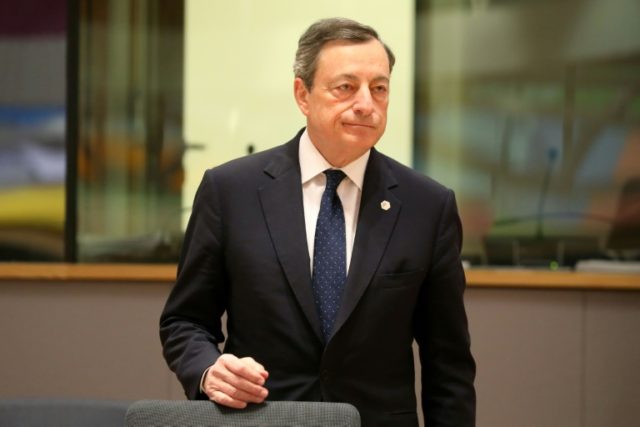Frankfurt am Main (AFP) – The European Central Bank upheld its massive support to the eurozone Thursday, avoiding rocking the boat as storm clouds gather on the economic horizon.
The Frankfurt institution kept its main refinancing rate at zero percent, the rate on the marginal lending facility at 0.25 percent, and on deposits at -0.4 percent, meaning banks pay to park money with the ECB.
Governors also decided to continue buying 30 billion euros ($36.5 billion) of government and corporate bonds per month under the “quantitative easing” (QE) stimulus programme.
Analysts had widely expected caution from the ECB after it ventured a burst of optimism in March, dropping a pledge to increase QE if the economy weakened again in a move policymakers said was backed by positive data.
Now all eyes will be on central bank chief Mario Draghi’s 2:30 pm (1230 GMT) press conference to explain the softly-softly approach.
“Draghi will have to strike a balance between recognising that economic data suggest the beginning of a slowdown, while saying (the ECB’s) March scenario of greater confidence it can bring inflation back towards its objective remains intact,” said Bank of America Merrill Lynch economist Gilles Moec.
Since governors last met, a slew of economic data has signalled that the single currency area got off to a rocky start this year after a robust 2017, complicating the ECB’s efforts to gradually exit its crisis-era stimulus measures.
Concerns about protectionist threats, geopolitical risks and global trade tensions have added to doubts about the strength of the eurozone recovery.
Draghi may face particularly probing questions about reports the German government expects the United States to impose tariffs on European metals imports — potentially sparking a transatlantic trade war that could undermine growth and inflation.
US President Donald Trump’s threats of tens of billions of dollars of border levies on Chinese imports and Beijing’s warning of a response in kind could also throw the world economy off track.
Even without such shocks, the ECB has long fallen short of its central price stability objective: inflation of just below 2.0 percent.
Price growth stood at 1.3 percent in March, and central bank forecasts call for it to reach just 1.7 percent by 2020.
But despite slow progress and shades of gloom, the ECB “must continue to hint at an announcement (of further policy changes) in June or July, to continue anchoring expectations of a normalisation” away from QE, said analyst Louis Harreau of Credit Agricole.
– Hints of slowdown –
Lower interest rates and QE are designed to pump cash through the financial system and into lending to firms and households — powering economic growth and inflation.
But after a near-euphoric second half of 2017 lifted annual growth to its highest level since 2007 — an expansion of 2.3 percent across the eurozone’s 19 nations — there are hints fewer positive surprises may be in store this year.
A key survey of eurozone business activity, the purchasing managers’ index, was unchanged in April at 55.2, data company IHS Markit said Monday.
The index has joined other indicators in losing some of the exuberance seen around the turn of the year, although the reading was above the 50-point mark that suggests economic expansion.
“The economy has shifted down a gear at the start of this year,” Commerzbank analyst Christoph Weil commented, but “there is no need to fear a massive plunge in economic growth”.
Both the ECB and the Washington-based International Monetary Fund have lifted their growth predictions for the eurozone to 2.4 percent in 2018.
As the central bank approaches technical limits to its bond-buying, it has little choice but to hope such forecasts come true as it tiptoes on a path out of QE defined by Draghi’s favourite adjectives: “confidence, patience, persistence and prudence”.

COMMENTS
Please let us know if you're having issues with commenting.